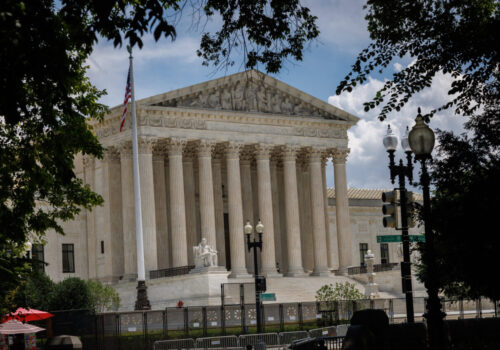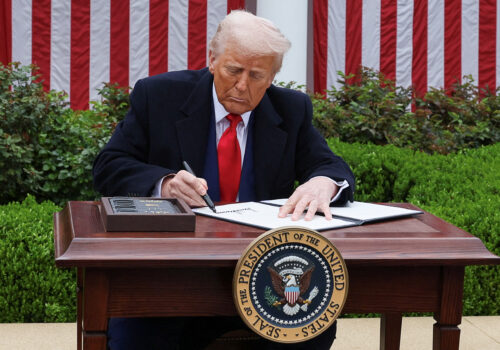The second Trump administration has embarked on a novel and aggressive tariff policy, citing a range of economic and national security concerns. This tracker monitors the evolution of these tariffs and provides expert context on the economic conditions driving their creation—along with their real-world impact.
Targeted economies
Reflects the additional ad valorem tariff rate on US imports since the beginning of the second Trump administration.
Click on or search for each country to learn more.
Targeted sectors
*Hover over text for more information
Exempt commodities
Sized by value of imports in 2024
Three ways to think about Trump’s tariffs
The Trump administration utilizes tariffs in three primary ways, depending on the objectives of any particular action.
- Negotiation tool: The administration sees tariffs as a way to put pressure on trade partners during negotiations, as well as a potential bargaining chip. Used in this way, tariff rates can increase US leverage and result in new trade agreements, like the US-China Phase One trade deal signed during President Donald Trump’s first term.
- Punitive tool: Trump administration officials have stated that they would like to avoid overuse of financial sanctions as a form of coercive economic statecraft, since they believe it can incentivize countries to reduce their reliance on the US dollar. As an alternative, the Trump administration is relying more on tariffs to “punish” or “sanction,” including for non-trade issues. The administration values the ability to easily escalate the tariff rate and, therefore, its punitive power.
- Macroeconomic tool: The Trump administration also, more conventionally, wields tariffs in support of a wide range of macroeconomic goals:
- Protecting domestic industries, such as steel, from unfair trading practices and encouraging domestic manufacturing.
- Decreasing US trade deficits.
- Increasing revenue from duties. Of course, the “Catch-22” is that if reshoring is successful, the United States will not be able to increase revenue from import duties.
Legal authorities invoked for the administration’s tariffs
The International Emergency Economic Powers Act (IEEPA)
During national emergencies, IEEPA gives the executive the power to “investigate, block during the pendency of an investigation, regulate, direct and compel, nullify, void, prevent or prohibit” a range of financial actions, including importation and exportation of property subject to the jurisdiction of the United States. The president must declare the emergency to Congress and publish it in the Federal Register and must subsequently report every six months on the actions taken to alleviate the emergency. Trump invoked IEEPA, among other authorities, to impose new tariffs on goods imports from China, Mexico, and Canada.
Historically, the majority of actions under IEEPA have been directed at blocking foreign transactions or freezing assets, and the use of IEEPA to levy import tariffs is unprecedented. The closest precedent is President Richard Nixon’s imposition of tariffs in 1971 under the Trading with the Enemy Act, which IEEPA amended in 1977. From 1977 to 2022, presidents have invoked IEEPA for sixty-seven different national emergencies.
Section 301
Section 301 of the Trade Act of 1974 gives the US Trade Representative (USTR) the authority to investigate foreign trade practices that violate trade agreements or disadvantage US commerce. If an investigation affirms unfair foreign trade practices, the executive branch can then respond with a range of trade measures, including suspending or withdrawing the benefits of a trade agreement, including the imposition of import tariffs.
This investigation process can begin with a petition that any person can file, or USTR itself will initiate a case. USTR must request consultations with the foreign government in question to attempt to address the grievances. A “Section 301 Committee,” which is part of the Trade Policy Staff Committee (TPSC), reviews the petitions and conducts public hearings, to then report findings and provide recommendations to the TPSC. The USTR must make a determination within twelve months after an investigation begins but can make a determination earlier. Section 301 tariffs expire after four years unless USTR decides to extend them.
Section 232
Section 232 of the Trade Expansion Act of 1962 gives the Commerce Department the authority to investigate if the quantity or circumstances of specific imports are a risk to national security. If the investigation finds there is a risk, the president must then respond and can do so by imposing tariffs or quotas. National security risks are defined broadly and can include a projected future risk to capacity or defense capabilities.
While any interested party can initiate a Section 232 investigation, the president, agency heads, or Commerce itself have initiated investigations (although this method has been little used until the previous Trump administration). Commerce has 270 days to report to the president on whether the imports pose a national security risk, but, in some cases, Commerce will complete the report more quickly. There is no termination date at which Section 232 actions expire.
National Emergencies Act
The National Emergencies Act (50 USC Ch. 34) grants the president the authority to declare a national emergency and terminate existing emergencies. This gives the White House unique powers to deal with crises, including the use of IEEPA.
Currently, there are approximately forty-four active national emergencies. Emergencies automatically terminate after a year unless renewed by the White House. Congress may terminate national emergencies through a joint resolution, which, if vetoed, requires a two-thirds majority to override. Congress has only terminated a national emergency through joint resolution once, ending the national emergency concerning the COVID-19 pandemic.
Section 604
Section 604 of the Trade Act of 1974 gives the president the authority to make changes to the Harmonized Tariff Schedule (HTS)—such as imposing, modifying, or removing tariffs and import restrictions—as necessary to implement US trade policy authorized under the Trade Act of 1974 or other trade statutes. It is a mechanism for carrying out decisions, rather than a source of authority in itself for creating new policies.
In recent history, it was cited by President Barack Obama in 2014 to terminate Russia’s status as a beneficiary developing country in General Note 4 of the Generalized System of Preferences. It was similarly cited by Trump in 2019 to terminate India’s status as a beneficiary developing country.
Section 122
Section 122 of the Trade Act of 1974 gives the President the authority to deal with “large and serious” balance-of-payments deficits through imposing temporary import tariffs up to 15% ad valorem. If such duties are insufficient, the President may also use import quotas. These measures can remain in place for 150 days, unless extended by Congress.
Actions taken under this authority must be applied in a non-discriminatory manner and should aim to maintain the existing distribution of trade. However, the President can target specific countries by exempting one or more countries that are not of concern, specifically those that do not have large or persistent balance-of-payments surpluses with the United States.
Section 338
Section 338 of the Tariff Act of 1930 allows the President to impose additional duties on countries that have discriminatory trade practices against the US. Discrimination against US commerce can include unreasonable tariffs, regulations, and limitations on US exports. This must uniquely disadvantage US exporters and not be applied universally. If this situation applies, the President may impose tariffs up to 50 percent of the value of the imported product from the country in question. If the discrimination continues further or increases, the President may also block all imports from the country.
Latest expert analysis
Acknowledgements
Author: Sophia Busch
Contributions from: Saddat Nazir, Charles Wheelock, and Matt Geraci
The research team would like to acknowledge Elizabeth Baltzan, Daniel Mullaney, and Barbara C. Matthews for their feedback on this project.
Explore the program

At the intersection of economics, finance, and foreign policy, the GeoEconomics Center is a translation hub with the goal of helping shape a better global economic future.



